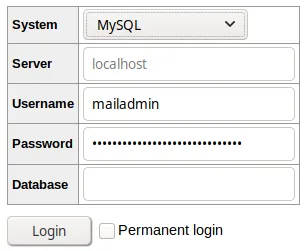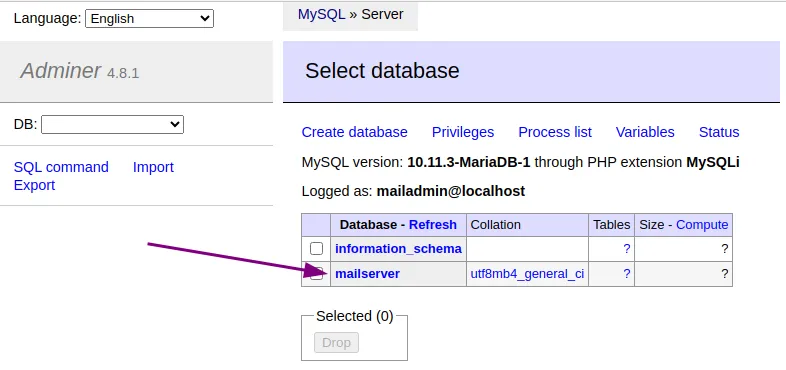Preparing the database
Now it’s time to prepare the MariaDB database that stores the information that controls your mail server. In the process you will have to enter SQL queries – the language of relational database servers. You may enter them in a terminal window using the ‘mysql’ command. But if you are less experienced with SQL you may prefer using a web interface. That’s what you installed Adminer for.
Setting up Adminer
Basically Adminer is just a couple of PHP files served from your Apache web server. The setup is simple. Edit your /etc/apache2/sites-available/webmail.example.org-https.conf file and put this line anywhere between the <VirtualHost> and the </VirtualHost> tags:
Alias /adminer /usr/share/adminer/adminerReload the Apache process:
systemctl reload apache2You will not be able to login yet. The only available database user is ‘root’, but it is only usable from the shell by default – not over a network.
Generate two random passwords
In this section you will create the basic database “mailserver” and two users. One user (“mailadmin”) will be able to change the data in the database and is meant for you. The other user (“mailserver”) can only read from the database and is meant for the server processes.
Use the pwgen tool to create two random passwords for these users:
pwgen -s1 30 2Take a note of the passwords or store them somewhere safe.
Create the ‘mailserver’ database
This step is simple. Connect to the database using the ‘mysql’ command:
mysqlYou should see the MariaDB prompt that allows you to enter further SQL commands:
MariaDB [(none)]>Now you are expected to speak SQL. To create a new database for our needs enter:
CREATE DATABASE mailserver;You will be told that your query was OK and that one new row was added.
Create the database users
Now you have an empty database. Let us give the “mailadmin” database user the required privileges to manage it.
You are still connected to the database, right? To create a user with full permissions enter this SQL command. Please use the first password you just generated instead of mine:
grant all privileges on mailserver.* to 'mailadmin'@'localhost' identified by 'gefk6lA2brMOeb8eR5WYaMEdKDQfnF';Also create the read-only user that will grant Postfix and Dovecot database access later (use your second random password here).
grant select on mailserver.* to 'mailserver'@'127.0.0.1' identified by 'x893dNj4stkHy1MKQq0USWBaX4ZZdq';Now you can use Adminer to log in using the mailadmin account and the first password:

You should get logged in and see the “mailserver” database:

Creating the database tables
Do you remember that I introduced three Postfix mappings earlier? One for virtual domains, one for virtual aliases and another for virtual users? Each of the mappings needs a database table that you will create now. Feel free to use Adminer. I will however also show the SQL statement to create the tables that you can enter on the ‘mysql’ command-line tool. Below you can click on either [Adminer] or [SQL] to choose.
The first table to create is…
virtual_domains
This table just holds the list of domains that you will use as virtual_mailbox_domains in Postfix.
| Column | Purpose |
|---|---|
| id | A unique number identifying each row. It is added by the database automatically. |
| name | The name of the domain you want to receive email for. |
USE mailserver;
CREATE TABLE IF NOT EXISTS `virtual_domains` ( `id` int(11) NOT NULL auto_increment, `name` varchar(50) NOT NULL, PRIMARY KEY (`id`) ) ENGINE=InnoDB DEFAULT CHARSET=utf8;virtual_users
The next table contains information about your users. Each mail account takes up one row.
| Column | Purpose |
|---|---|
| domain_id | Contains the number of the domain’s id in the virtual_domains table. This is called a foreign key. A “delete cascade” makes sure that if a domain is deleted that all user accounts in that domain are also deleted to avoid orphaned rows. |
| The email address of the mail account. | |
| password | The hashed password of the mail account. It is prepended by the password scheme. By default it is {BLF-CRYPT} also known as bcrypt which is considered very secure. Previous ISPmail guides used {SHA256-CRYPT} or even older crypt schemes. Prepending the password field the hashing algorithm in curly brackets allows you to have different kinds of hashes. So you can easily migrate your old passwords without locking out users. Users with older schemes should get a new password if possible to increase security. |
| quota | The number of bytes that this mailbox can store. You can use this value to limit how much space a mailbox can take up. The default value is 0 which means that there is no limit. |
CREATE TABLE IF NOT EXISTS `virtual_users` ( `id` int(11) NOT NULL auto_increment, `domain_id` int(11) NOT NULL, `email` varchar(100) NOT NULL, `password` varchar(150) NOT NULL, `quota` bigint(11) NOT NULL DEFAULT 0, PRIMARY KEY (`id`), UNIQUE KEY `email` (`email`), FOREIGN KEY (domain_id) REFERENCES virtual_domains(id) ON DELETE CASCADE ) ENGINE=InnoDB DEFAULT CHARSET=utf8;virtual_aliases
The last table contains forwardings from an email address to other email addresses.
| Field | Purpose |
|---|---|
| id | A unique number identifying each row. It is added by the database automatically. |
| domain_id | Contains the number of the domain’s id in the virtual_domains table again. |
| source | The email address that the email was actually sent to. In case of catch-all addresses (that accept any address in a domain) the source looks like “@example.org”. |
| destination | The email address that the email should instead be sent to. |
CREATE TABLE IF NOT EXISTS `virtual_aliases` ( `id` int(11) NOT NULL auto_increment, `domain_id` int(11) NOT NULL, `source` varchar(100) NOT NULL, `destination` varchar(100) NOT NULL, PRIMARY KEY (`id`), FOREIGN KEY (domain_id) REFERENCES virtual_domains(id) ON DELETE CASCADE ) ENGINE=InnoDB DEFAULT CHARSET=utf8;As described in the section about domain types there can be multiple targets for one source email address. You just would need to insert several rows with the same source address and different destination addresses that will get copies of an email. Postfix will consider all matching rows.
Example data to play with
Too much theory so far? I can imagine. Let’s populate the database with an example.org domain, a john@example.org email account and a forwarding of jack@example.org to john@example.org. We will use that information in the next chapter to play with.
To add that sample data just run these SQL queries:
REPLACE INTO mailserver.virtual\_domains (id,name) VALUES ('1','example.org');
REPLACE INTO mailserver.virtual\_users (id,domain\_id,password,email) VALUES ('1', '1', '{BLF-CRYPT}$2y$05$.WedBCNZiwxY1CG3aleIleu6lYjup2CIg0BP4M4YCZsO204Czz07W', 'john@example.org');
REPLACE INTO mailserver.virtual\_aliases (id,domain\_id,source,destination) VALUES ('1', '1', 'jack@example.org', 'john@example.org');Do you wonder how I got the long cryptic password? I ran…
doveadm pw -s BLF-CRYPT…to create a secure hash of the simple password “summersun”. Once you have installed Dovecot you can try that yourself but you will get a different output. The reason is that the passwords are salted to increase their security.
Remember to remove that sample data before you go live with your mail server. Thanks to the delete cascade you just need to remove the virtual_domain. The alias and the mailbox will be deleted automatically. This would be the SQL query you should run before taking your mail server into production:
DELETE FROM mailserver.virtual\_domains WHERE name='example.org';